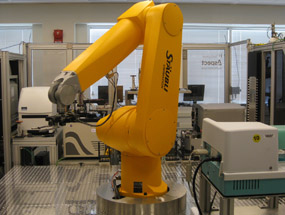Ushering In a New Generation of Chemical Screening
By Richard Judson
I work with EPA colleagues and other scientists around the world to integrate advances in biology, biotechnology, chemistry, and computer science to evaluate thousands of chemicals. Part of our research is supporting EPA’s Endocrine Disruptor Screening Program, exploring the potential for chemicals to disrupt normal growth and development in humans and other animals.
The work we do is helping usher in a new generation of faster, more efficient, and far less costly chemical screening methods. We use automated technologies, called high-throughput screening assays, to expose cells and proteins to chemicals. We then screen them to identify any that exhibited changes in biological activity that may suggest the potential for endocrine disruption.
My partners and I are excited to announce that we have recently published two papers on results of our work. We used the innovative methods described above to screen chemicals for their potential to mimic normal estrogen hormones, substances that direct development and reproduction. Exposure to chemicals that mimic estrogen pose a range of potential health risks, including birth defects and certain types of cancer.
The first paper, published in Nature Scientific Reports, describes the results of screening approximately 10,500 chemicals. The screening included 88 duplicates of the same chemicals, which validated the reliability of the assays. It also included 39 reference chemicals—those whose estrogen-receptor activity have been well established through traditional testing methods. Using the reference chemicals showed that the assays could accurately identify chemicals that were both positive and negative for their ability to mimic natural estrogens.
This paper is a product of Tox21, a federal collaboration pooling expertise and resources among EPA, the National Toxicology Program (National Institute of Environmental Health Sciences), the Food and Drug Administration, and the National Center for Advancing Translational Sciences (NCATS). Tox21 was established to study how high-throughput screening methods can be used to evaluate thousands of chemicals. These assays were run on the NCATS ultra-high-throughput robotic screening system (pictured).
The second paper (selected by the American Chemical Society’s Environmental Science and Technology journal as an editor’s choice) describes the results of screening 1,814 chemicals (including 36 reference chemicals). The screening was performed using a panel of 13 high-throughput estrogen receptor assays that use a diverse set of cell types and assay technologies.The results indicate that such a panel can accurately predict estrogenic responses. It demonstrates how the resulting data could be used for chemical prioritization as part of the Agency’s Endocrine Disruptor Screening Program.
In December 2013, we publicly released our high-throughput screening data through user-friendly web applications called interactive Chemical Safety for Sustainability (iCSS) Dashboards. I encourage anyone with an interest in this research to take a look at the data and to also participate in EPA’s Second ToxCast Data Summit. The summit is scheduled for September 29-30, 2014 in Research Triangle Park, NC.
The goal of the summit is to bring together the user community (industry, non-governmental organizations, academia, governmental agencies and more) to present their ideas for ways to use the large amount of high-throughput screening data to help inform chemical policy and regulatory decisions.
About the Author: EPA scientist Dr. Richard Judson develops databases and computer applications to model and predict toxicological effects of a wide range of chemicals. He is a member of the EPA Computational Toxicology research team where he leads the effort in bioinformatics. Dr. Judson has a BA in Chemistry and Chemical Physics from Rice University and an MA and PhD in Chemistry from Princeton University.
Information About the Papers
Profiling of the Tox21 10K compound library for agonists and antagonists of the estrogen receptor alpha signaling pathway. Ruili Huang, Srilatha Sakamuru, Matt T. Martin, David M. Reif, Richard S. Judson, Keith A. Houck, Warren Casey, Jui-Hua Hsieh, Keith Shockley, Patricia Ceger, Jennifer Fostel, Kristine L. Witt, Weida Tong, Daniel M. Rotroff,2 Tongan Zhao, Paul Shinn, Anton Simeonov, David J. Dix, Christopher P. Austin, Robert J Kavlock, Raymond R. Tice, Menghang Xia. Nature Scientific Reports
Predictive Endocrine Testing in the 21st Century Using in Vitro Assays of Estrogen Receptor Signaling Responses. Daniel M. Rotroff, Matt T. Martin, David J. Dix, Dayne L. Filer, Keith A. Houck, Thomas B. Knudsen, Nisha S. Sipes, David M. Reif, Menghang Xia, Ruili Huang, and Richard S. Judson. Environmental Science & Technology

